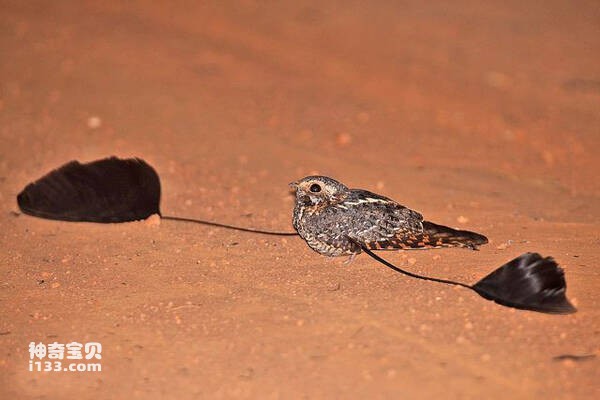Macrodipteryx longipennis
IUCN
LCBasic Information
Scientific classification
- name:Macrodipteryx longipennis
- Scientific Name:Macrodipteryx longipennis,Standard-winged Nightjar
- Outline:Climbing birds
- Family:
Vital signs
- length:20-23cm
- Weight:No textual research information is available
- lifetime:No textual research information is available
Feature
Distribution and Habitat
It is found in the dry savannas of Africa from Senegal to Ethiopia.
Appearance
It is 20-23 cm long. The beak is short and the mouth is large, the nose is tubular, the wings are long and pointed, the feathers are soft and clearly spotted, and the tail is convex. There was little difference between male and female birds in breeding season.
Details
Macrodipteryx longipennis (also known as Standard-winged Nightjar) is a four-winged bird found in the savannas and forests of Africa.

They do not nest, and the two long oval eggs are laid directly on the ground. They fly at dusk and are often as quiet and light as moths at sunset. In flight, they open their mouths wide to hunt moths and beetles. During the day they rest on the ground.
< img SRC = "/ static/upload/images / 20230415/2023041510422232. JPG" title = "2023041510422232 JPG" Alt = "f + 31 g3a1_ nine ray image converter. JPG" / >
Males develop one long feather on each wing during the breeding season - a fly feather extending up to 38 cm in the middle of the wing, and a bare stem 20 cm or more up from the base. In normal flight, this feather drags behind. When the mating display flies, the male flaps his wings quickly to raise his two long feathers, like two flags. Since there are no muscles to control the two long feathers, they flutter in the wind. Males without these two "flags" will not be accepted by females. Although these two long feathers are important for courtship, they are a hindrance to the flag-winged nighthawk in other ways. As soon as the breeding season is over, the male will peck down these two long feathers.
Protect wild animals and eliminate wild meat.
Maintaining ecological balance is everyone's responsibility!








